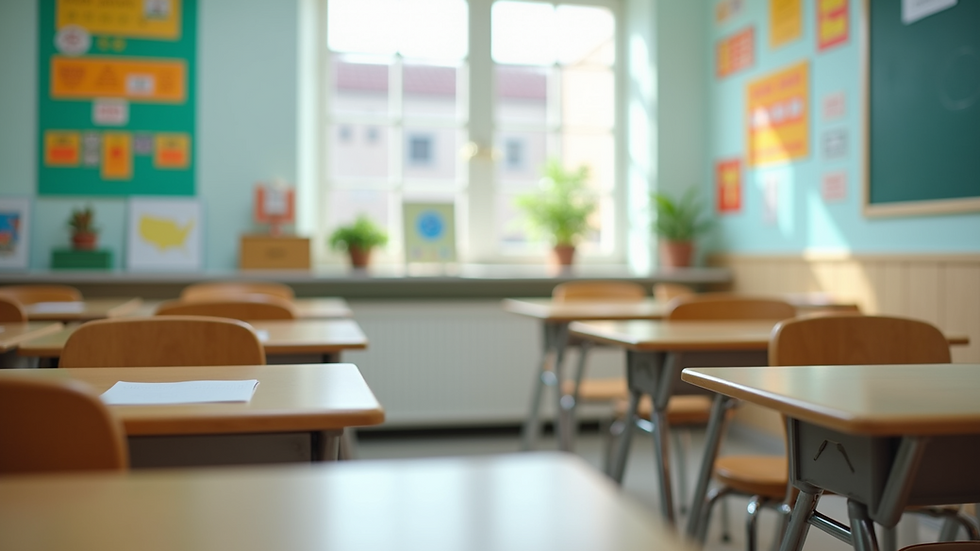Back-to-School Cleaning Tips for Daycares and Schools to Ensure a Safe Learning Environment
- Griselda's Cleaning
- Aug 18
- 4 min read
As the back-to-school season nears, daycares and schools must focus on cleanliness and hygiene. A clean environment not only promotes health but also boosts children's learning experiences. Implementing effective cleaning strategies allows educators and caregivers to create a safe and inviting atmosphere for students. Here are essential cleaning tips to prepare your daycare or school for the new academic year.
Assessing the Cleaning Needs
Before starting the cleaning process, it’s vital to assess the specific needs of your facility. Walking through each classroom, common area, and outdoor space will help identify high-traffic zones that need extra attention.
Creating a checklist can simplify this assessment. Include areas that require cleaning, such as:
Classrooms
Play areas
Restrooms
Cafeterias
Hallways
This organized approach will help you prioritize tasks and allocate resources effectively.
Deep Cleaning Classrooms
Classrooms serve as the heart of educational institutions, making thorough cleaning essential before the school year begins. Begin by removing items from desks, shelves, and floors. Dust every surface, including light fixtures and window sills. Be sure to wipe down all furniture with a disinfectant.
If you have carpets, consider steam cleaning them to eliminate allergens. Regular vacuuming is also effective, especially if statistics show that up to 80% of dust in classrooms settles on the floor.

Sanitizing Common Areas
Common areas, including hallways, cafeterias, and restrooms, often harbor germs. Regular sanitization is crucial for maintaining a healthy environment. Use EPA-approved disinfectants to wipe down frequently touched surfaces, such as doorknobs, handrails, and light switches.
In restrooms, confirm that soap dispensers are filled and that paper towels or hand dryers are functional. Encouraging students to wash their hands frequently can significantly reduce the spread of germs. In fact, proper handwashing can decrease the likelihood of respiratory infections by 21%.
Outdoor Spaces and Play Areas
Outdoor play areas are vital for children’s physical and social development, but they also need regular upkeep. Inspect playground equipment for hazards like rust or loose parts, and clean surfaces to eliminate dirt and debris.
Scheduling routine maintenance for outdoor spaces is beneficial. For example, mowing lawns can reduce allergens, while trimming bushes can prevent hiding spots for pests. A well-maintained outdoor area not only enhances safety but also motivates children to engage in physical activities, with studies showing that physical play can enhance focus in the classroom.
Implementing a Cleaning Schedule
Creating a cleaning schedule ensures that all areas of your daycare or school are consistently maintained throughout the year. Assign specific tasks to staff members and establish a routine for daily, weekly, and monthly cleaning.
Daily tasks might include:
Emptying trash bins
Wiping down surfaces
Sweeping or vacuuming floors
Weekly tasks could involve:
Deep cleaning restrooms
Dusting high surfaces
Sanitizing toys and learning materials
Monthly tasks might include:
Cleaning windows
Shampooing carpets
Inspecting and maintaining outdoor equipment
By breaking down cleaning into manageable tasks, it reduces overwhelm and ensures thoroughness.
Educating Staff and Students
Education plays a critical role in sustaining a clean environment. Train staff on proper cleaning techniques and emphasize the importance of hygiene. Encourage them to model good habits, like washing hands regularly and maintaining tidy workspaces.
Additionally, teaching students about cleanliness can help foster a culture that values hygiene. For instance, simple lessons on the right way to wash hands or how to keep personal items organized can make a significant impact on their daily routine.
Involving Parents
Parents can be valuable allies in maintaining a clean and safe learning environment. Consider sending newsletters to discuss the significance of cleanliness and hygiene. Reinforce these values at home, so children understand their importance.
Organizing community clean-up days is another effective strategy. Parents and staff can come together to tidy up the school grounds or classrooms. This not only helps with cleanliness but also builds a sense of community and collaboration among families and educators.
Choosing the Right Cleaning Products
Selecting safe and effective cleaning products is crucial. Look for non-toxic, eco-friendly solutions that are free from harsh chemicals. Products that have been certified safe for children’s use can help ensure the well-being of students and staff.
Be sure to store all cleaning supplies out of children's reach. Clearly label all products and provide training to staff on their proper use to ensure safety.
Evaluating and Adjusting Cleaning Practices
Throughout the school year, monitoring your cleaning practices is essential for maintaining effectiveness. Collect feedback from staff, parents, and students to identify areas that may need improvement.
Be open to adjusting your cleaning schedule and methods based on the needs of your facility. Regular evaluations will help ensure that your daycare or school continues to be a safe and clean environment for everyone.
Wrapping Up
As the back-to-school season approaches, implementing these cleaning tips can support daycares and schools in creating a safe and welcoming environment. By prioritizing cleanliness, educators and caregivers foster a positive learning atmosphere that promotes health and well-being. A proactive approach to cleaning and hygiene can ensure readiness for a new academic year. Remember, a clean school is not just about looks; it is about crafting a safe space where children can thrive and learn effectively.





Comments